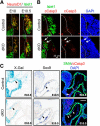HDAC1 and HDAC2 control the specification of neural crest cells into peripheral glia
- PMID: 24760871
- PMCID: PMC3996228
- DOI: 10.1523/JNEUROSCI.5212-13.2014
HDAC1 and HDAC2 control the specification of neural crest cells into peripheral glia
Abstract
Schwann cells, the myelinating glia of the peripheral nervous system (PNS), originate from multipotent neural crest cells that also give rise to other cells, including neurons, melanocytes, chondrocytes, and smooth muscle cells. The transcription factor Sox10 is required for peripheral glia specification. However, all neural crest cells express Sox10 and the mechanisms directing neural crest cells into a specific lineage are poorly understood. We show here that histone deacetylases 1 and 2 (HDAC1/2) are essential for the specification of neural crest cells into Schwann cell precursors and satellite glia, which express the early determinants of their lineage myelin protein zero (P0) and/or fatty acid binding protein 7 (Fabp7). In neural crest cells, HDAC1/2 induced expression of the transcription factor Pax3 by binding and activating the Pax3 promoter. In turn, Pax3 was required to maintain high Sox10 levels and to trigger expression of Fabp7. In addition, HDAC1/2 were bound to the P0 promoter and activated P0 transcription. Consistently, in vivo genetic deletion of HDAC1/2 in mouse neural crest cells led to strongly decreased Sox10 expression, no detectable Pax3, virtually no satellite glia, and no Schwann cell precursors in dorsal root ganglia and peripheral nerves. Similarly, in vivo ablation of Pax3 in the mouse neural crest resulted in strongly reduced expression of Sox10 and Fabp7. Therefore, by controlling the expression of Pax3 and the concerted action of Pax3 and Sox10 on their target genes, HDAC1/2 direct the specification of neural crest cells into peripheral glia.
Keywords: histone deacetylases; neural crest cells; peripheral glia specification; transcriptional control.
Figures








Similar articles
-
Early acquisition of neural crest competence during hESCs neuralization.PLoS One. 2010 Nov 9;5(11):e13890. doi: 10.1371/journal.pone.0013890. PLoS One. 2010. PMID: 21085480 Free PMC article.
-
Temporal Analysis of Gene Expression in the Murine Schwann Cell Lineage and the Acutely Injured Postnatal Nerve.PLoS One. 2016 Apr 8;11(4):e0153256. doi: 10.1371/journal.pone.0153256. eCollection 2016. PLoS One. 2016. PMID: 27058953 Free PMC article.
-
Temporally regulated neural crest transcription factors distinguish neuroectodermal tumors of varying malignancy and differentiation.Neoplasia. 2005 Jun;7(6):575-84. doi: 10.1593/neo.04637. Neoplasia. 2005. PMID: 16036108 Free PMC article.
-
Sox appeal - Sox10 attracts epigenetic and transcriptional regulators in myelinating glia.Biol Chem. 2013 Dec;394(12):1583-93. doi: 10.1515/hsz-2013-0146. Biol Chem. 2013. PMID: 23729567 Review.
-
Specification, plasticity and evolutionary origin of peripheral glial cells.Curr Opin Neurobiol. 2017 Dec;47:196-202. doi: 10.1016/j.conb.2017.11.004. Epub 2017 Nov 20. Curr Opin Neurobiol. 2017. PMID: 29161639 Review.
Cited by
-
A fibrin matrix promotes the differentiation of EMSCs isolated from nasal respiratory mucosa to myelinating phenotypical Schwann-like cells.Mol Cells. 2015 Mar;38(3):221-8. doi: 10.14348/molcells.2015.2170. Epub 2015 Feb 4. Mol Cells. 2015. PMID: 25666351 Free PMC article.
-
NOTCH1 and SOX10 are Essential for Proliferation and Radiation Resistance of Cancer Stem-Like Cells in Adenoid Cystic Carcinoma.Clin Cancer Res. 2016 Apr 15;22(8):2083-95. doi: 10.1158/1078-0432.CCR-15-2208. Clin Cancer Res. 2016. PMID: 27084744 Free PMC article.
-
Schwann Cell Precursors; Multipotent Glial Cells in Embryonic Nerves.Front Mol Neurosci. 2019 Mar 26;12:69. doi: 10.3389/fnmol.2019.00069. eCollection 2019. Front Mol Neurosci. 2019. PMID: 30971890 Free PMC article. Review.
-
Histone deacetylases 1 and 2 regulate the transcriptional programs of nephron progenitors and renal vesicles.Development. 2018 May 18;145(10):dev153619. doi: 10.1242/dev.153619. Development. 2018. PMID: 29712641 Free PMC article.
-
Schwann cell development, maturation and regeneration: a focus on classic and emerging intracellular signaling pathways.Neural Regen Res. 2017 Jul;12(7):1013-1023. doi: 10.4103/1673-5374.211172. Neural Regen Res. 2017. PMID: 28852375 Free PMC article. Review.
References
-
- Antonellis A, Huynh JL, Lee-Lin SQ, Vinton RM, Renaud G, Loftus SK, Elliot G, Wolfsberg TG, Green ED, McCallion AS, Pavan WJ. Identification of neural crest and glial enhancers at the mouse Sox10 locus through transgenesis in zebrafish. PLoS Genet. 2008;4:e1000174. doi: 10.1371/journal.pgen.1000174. - DOI - PMC - PubMed
-
- Auerbach R. Analysis of the developmental effects of a lethal mutation in the house mouse. Journal of Experimental Zoology. 1954;127:305–329. doi: 10.1002/jez.1401270206. - DOI
Publication types
MeSH terms
Substances
Grants and funding
LinkOut - more resources
Full Text Sources
Other Literature Sources
Molecular Biology Databases
Research Materials
Miscellaneous
